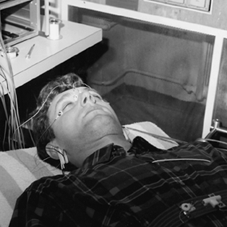CANDY Analysis of Physiological Data from the Wake-Sleep Transition with Neural Networks
by Klaus-Robert Müller
Methods for the analysis of non-stationary time series were developed in the project CANDY (Connectionist Analysis of Nonlinear DYnamics). The algorithms use artificial neural networks and reach a high time resolution in the examination of physiological data from a sleep laboratory.
Goals of the data analysis are on one side a classification of the sleep stages (segmentation) and on the other side a more accurate resolution of the transition between the wake and the sleep phase (learning of the dynamics of each phase). The data include heart rate, blood pressure, Electroencephalogram (EEG), respiratory signals, Electrooculogram (EOG), Electrocardiogram (ECG).
Scenario
At present, clinical methods work with a rough time resolution of more than one minute. This means that a prediction or detailed investigation of the exact form of the transition between wake and sleep stages is so far not possible with a machine. The transitions are - also for this reason - not well understood.
 Experimental setup.
Experimental setup.
Our approach (ACE: Annealed Competition of Experts) using neural networks can reach time resolutions below one second and it is unsupervised, ie it finds automatically (data driven) the dynamical modes which are responsible for the different wake and sleep stages. This is achieved by employing an ensemble of neural networks, which specialise on the different modes during a learning phase. Within this framework, the networks learn to predict the signal of their respective mode. The automatically extracted state segmentation of the neural networks agrees nicely with the diagnosis of a human medical expert.
Application
From the medical point of view we want to characterize the wake-sleep transition itself in greater detail, in order to detect potential anomalies, which could arise eg in the context of sleep disorders. A potential future application of our research would therefore be the diagnosis and treatment of sleep disorders.
Since our neural network approach learns the dynamics of the wake and sleep phases, we consider the prediction of the transition point from wake to sleep, or the prediction of the time when the attention is below a certain threshold, as another possible application. In this context, we could think of a technical system that warns a driver of a car who reaches a dangerous state of drowsiness before he actually would fall asleep and cause a lot of harm.
Partners
We study the physiological data from a sleep laboratory in collaboration with the Institute for Physiology of the Free University of Berlin and the Institute for Theoretical Physics of the University of Frankfurt (Main).
More information at: http://www.first.gmd.de/org/candy.html
Please contact:
Klaus-Robert Müller - GMD
Tel: +49 30 6329 1860
E-mail: klaus@first.gmd.de
